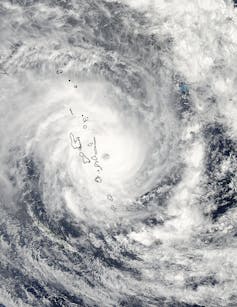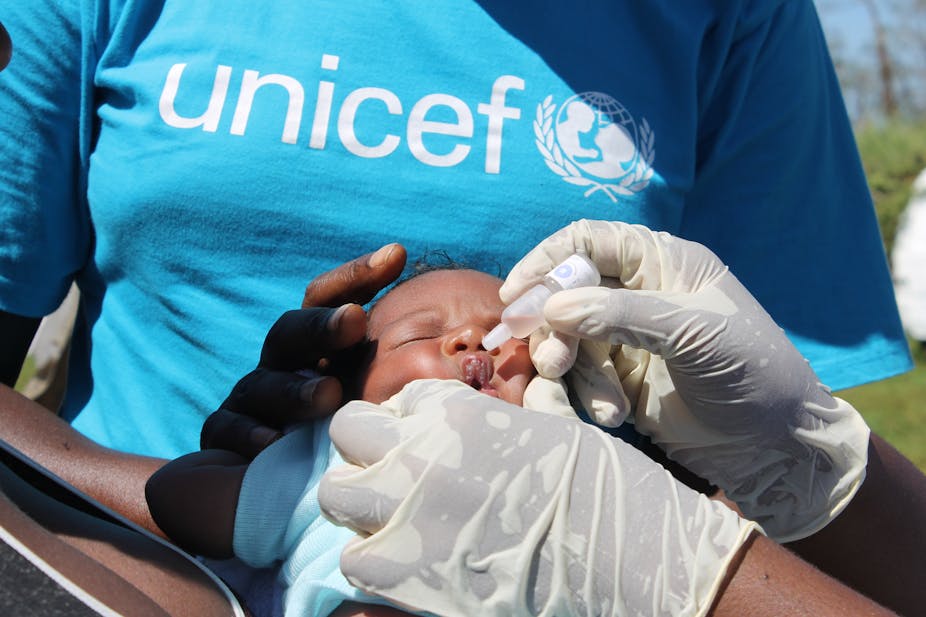While extreme weather events such as Cyclone Pam are not unexpected in the Pacific, climate change poses devastating challenges for countries like Vanuatu by further altering the patterns of tropical cyclones in coming years.
Providing disaster response in a country with more than 80 islands and a population of 262,691 people – 80% of whom live rural and subsistence lifestyles – is challenging and complex. Vanuatu’s future disaster response needs to build on strengths of the existing system – for example, the institutional structures of response – and tackle gaps, such as the overstretched health sector.
In 2012, we assessed the disaster-response system and the capacity to meet some of the immediate needs of communities after disasters in Vanuatu and other Pacific Islands. This research followed Cyclone Jasmine, a category four storm, when far less damage was reported than for Cyclone Pam. However, the research findings remain relevant.
We found a disaster-response system that, while struggling with limited resources, was well co-ordinated.
Vanuatu’s National Disaster Management Office (NDMO) is the lead agency for disaster co-ordination. It is supported by the Vanuatu Humanitarian Team (VHT) – a network of government and non-government organisations, Red Cross and United Nations agencies that form “clusters” (such as shelter, health and nutrition, education), following the global UN system to prepare for and respond to disasters.
The VHT’s approach was co-ordinated and inclusive. It acknowledged the need for collective national preparedness and co-operation, and involved both government and non-government actors. It would be hard to ask for more.
Building on traditional coping mechanisms
In Vanuatu and elsewhere in the Pacific, traditional coping mechanisms help to significantly lessen disaster impacts. For example, in Vanuatu, observations of sea birds indicate impending strong winds, alerting local people to prepare adequately. Such local response capacity is now being reinforced through provincial disaster committees based in outlying islands, offering co-ordination and support at a more local level.
However, local capacity to cope with destructive events is inevitably constrained by shortages of personnel, resources and infrastructure. This is certainly apparent with Cyclone Pam. For example, damage to communications infrastructure in remote areas has reduced the ability to inform authorities in the capital, Port Vila, of the scale of impacts. This hampers the ability to provide effective, targeted and timely relief.
A key finding of our study was that, in Vanuatu, it was the strength of trusting relationships between key individuals that supported effective disaster response. Relationships between individuals in key organisations like the NDMO and VHT helped overcome information and communication gaps. Strategies that reinforce such relationships and connections across “clusters” and at local level, and between key individuals, could improve disaster co-ordination.
Past events illustrated that the speed and effectiveness of response were reliant on being connected to the right people. Donor countries and non-governmental organisations (NGOs) need to be mindful of this finding. Incoming resources, both human and material, that are not directed through formal systematic channels (NDMO and VHT) can cause confusion and place a burden on already over-stretched local disaster responders.
Health resources are limited
Shortages in nurses and health staff affect Vanuatu’s ability to respond. This issue was discussed at meetings of the South Pacific Chief Nurses and Midwifery Officers Alliance with the World Health Organisation Collaborating Centre at UTS.
Health needs, including the “Health and Nutrition Cluster”, are co-ordinated by the Ministry of Health. The health of Vanuatu’s island population is administered through five main hospitals and two key referral hospitals, with only health centres and aid posts on the outlying islands.
There are approximately 350 nurses and midwives who, as our research found, are the frontline disaster responders. However, this isn’t enough to sustain a healthy population in normal times, let alone following a major disaster. A disaster responder told us:
District hospitals are short-staffed. They have enough to keep going now (just), but once something happens they could not keep up.
We also found health and medical supplies to be severely lacking, leading to high levels of vulnerability in disaster situations when supplies are needed on a large scale. Given this finding, co-ordination with, and support to, the Health Ministry after Cyclone Pam is paramount as its staff oversee the distribution of medical supplies and administration of disaster medical services.
Overcoming gaps in the response system

Food and nutrition needs that arise after disasters were found not to be prioritised by either government or NGOs in Vanuatu. The strong cultural and social support mechanisms that feature in Vanuatu culture were relied on to provide adequate food within communities after disasters.
Given the intensity of Cyclone Pam and its far-reaching impacts in some areas, this is an area where outside assistance will be greatly needed. The agriculture minister has already highlighted this need, calling for support through the short-term provision of food while crops are replanted and rehabilitated.
Dealing with post-disaster trauma and distress was also a significant gap in Vanuatu. We heard from the Health Ministry that:
We have food and water, but the people we often forget. It is sometimes neglected – there are limited activities around psychosocial needs.
People assumed that Vanuatu’s churches would provide for such needs. In reality, this support was not always available. Some capacity to provide psychosocial support existed within the Health Ministry, but it was limited. Culturally appropriate help in this area will be required.
Capacity to deal with disasters in Vanuatu has its strengths (such as strong and trusting relationships among individuals in key organisations such as the NDMO and VHT) and weaknesses (such as a highly-stretched health sector).
Progress in dealing with future disasters needs to focus on information flows between clusters and improving local levels of preparedness. In the longer term, effective capacity-building through mentoring (rather than discrete training sessions) and partnerships will serve countries like Vanuatu better to cope with the range of disaster events they inevitably face in years to come.

